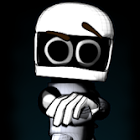
I've thought a lot about this and can see problems, limitations and disadvantages for someone to undertake such a project. Such as, would this have to be done in a controlled environment, like a studio where lighting can be adjusted accordingly, to different lighting situations? I mean wouldn't the only real reason to do something like this be, to get the different light and shadow information on the actor when they are performing different movements, along with the skin textures? What about the possibility of 3d (or even 2d) plane gameplay? Also, I wanted to make mention that part of my idea involved emulating your real life surrounding in the game, and make it a fighter, if necessary.
Could any of this actually work? What haven't I realized? I'm quite positive there to be massive holes in this concept, that I haven't thought of. What about limitations in terms of character attire, amount of lights, cosmetic effects, backgrounds, props, etc...
But someone explained to me that currently the reason we aren't able to get photo-realistic real-time graphics on current hardware is because we can't support the cooling CPU's would require to handle such on screen rendering, or something along these lines. But he said this most likely will be possible in the next 20 years or so. I'm just trying to think of ways to cheat that time :P








